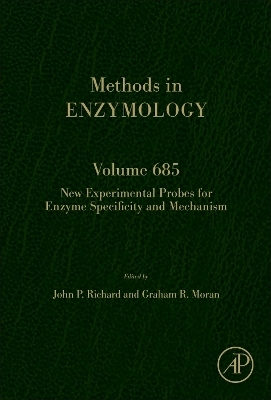
New Experimental Probes for Enzyme Specificity and Mechanism
Academic Press Inc (Verlag)
978-0-443-15276-4 (ISBN)
Additional chapters cover Kinetics and Mechanism for Reactions of Enzyme Pieces, Evaluation of allostery for the bienzyme assembly of a 3-deoxy-D-arabino heptulosonate-7-phosphate synthase and chorismate mutase, Recognition and Catalysis of Reactions of Chiral Substrates by Mandelate Racemase, Innovative and emerging modalities of EGFR kinase inhibitors, Characterization of the Aminoacrylate Intermediate of Tyrosine Phenol-Lyases, and much more.
John Richard received his Ph.D. from Ohio State University, under the direction of Perry Frey. His thesis reported the synthesis of chiral oxygen-18 labelled phosphorothioate analogs of adenine nucleotides, and their use to determine the stereochemical course for enzyme-catalyzed phosphoryl transfer reactions. He worked as a postdoctoral fellow at Brandeis University with Bill Jencks, and developed an azide ion clock to measure the lifetimes of carbocation intermediates of solvolysis reactions. This clock was used to show that the mechanism for nucleophilic substitution reactions at ring-substituted 1 phenylethyl derivatives is controlled by the lifetimes of the carbocation intermediates of the solvolysis reaction. He began his independent career at the Department of Chemistry at the University of Kentucky in 1985 and moved to SUNY Buffalo in 1993. Richard is interested in understanding the mechanism for the reactions of small molecules in water, and for their catalysis by enzymes. His early independent studies focused on developing methods to determine rate and equilibrium constants for reactions of simple carbanions and carbocations intermediates of organic reactions in water. This led to a broad characterization of substituent effects on the stability of these intermediates, and a rationale for the observation that many polar electron-withdrawing substituents cause a decrease in both the stability and reactivity of resonance stabilized carbocations. Richard transitioned to studies on the mechanism for small molecule catalysis in models for enzyme-catalyzed reactions. These included proton transfer, hydride transfer, aldol condensation reactions, and phosphate diester hydrolysis. Most recently he has focused on determining the mechanism for the stabilization of reactive carbocation and carbanion enzymatic reaction intermediates through interactions with active-site protein side chains. An important outcome of this work is the determination that the most proficient enzyme catalysts of metabolic reactions utilize substrate binding interactions as glue in the construction of protein-substrate cages that provide a tremendous stabilization of carbanion and carbocation reaction intermediates. These results provide a simple rational for the existence of enzyme catalysts that follow Koshland's induced-flt mechanism. Professor Graham Moran began his doctoral at the University of New England Australia working under Dr. Barrie Entsch on the enzyme para-hydroxybenzoate hydroxylase. After completing two years of doctoral work, he came to the University of Michigan to work collaboratively with the research group of Dr. David Ballou. He then continued his studies as a postdoctoral researcher in the laboratory of Dr. Paul Fitzpatrick at Texas A&M University working on tryptophan hydroxylase. Dr. Moran then established his independent research program in the Department of Chemistry and Biochemistry at the University of Wisconsin-Milwaukee where his laboratory was based for 18 years. During this period his group studied numerous enzymes, including 4-hydryphenylpyruvate dioxygenase, hydroxymandelate synthase, kynurenine-3-monooxygenase and renalase. In 2018, Dr. Moran joined Loyola University Chicago Chemistry and Biochemistry Department, as the Carl Moore Research Chair. His group currently studies enzymes of riboflavin biosynthesis (RibA, RibB, RibD), dihydropyrimidine dehydrogenase, isocitrate dehydrogenase, and glutathione-thioredoxin reductase. The unifying theme of his career has been finding evidence for the chemical mechanisms of enzymes. Identifying the transient states that exist as an enzyme catalyzes reaction requires the use of rapid mixing spectrophotometric and quench methods in combination with a variety of tailored analysis protocols. While a number of the enzyme systems studied in the Moran research group have had direct applications in medicine and agriculture, the emphasis of the work has remained elucidation of the curious and intricate chemistry at work in each system.
1. Subverting Hedgehog Protein Autoprocessing by Chemical Induction of Paracatalysis
2. New Mechanistic Probes to Identify Novel Substrates for N-Myristoyltransferases
3. Phosphonate and a Fluorophosphonate Analogues of D Glucose 6 Phosphate as Active-Site Probes of 1L-Myo-Inositol 1 phosphate Synthase
4. Kinetic Mechanism of Nicotine-Degrading Enzyme Probed by Stopped-Flow Kinetic Analyses
5. Kinetics and Mechanism for Enzyme-Catalyzed Reactions of Substrate Pieces
6. Kinetics and Mechanism for Reactions of Enzyme Pieces
7. Evaluation of allostery for the bienzyme assembly of a 3-deoxy-D-arabino heptulosonate-7-phosphate synthase and chorismate mutase
8. Recognition and Catalysis of Reactions of Chiral Substrates by Mandelate Racemase
9. Innovative and emerging modalities of EGFR kinase inhibitors
10. Characterization of the Aminoacrylate Intermediate of Tyrosine Phenol-Lyases
11. Employing deuterium kinetic isotope effects to uncover the mechanism of (R)-3-hydroxybutyrate dehydrogenase
12. Probing the mechanism of flavin action in the oxidative decarboxylation catalyzed by salicylate hydroxylase
13. Kinetic Characterization of Methylthio-D-ribose-1-phosphate Isomerase
14. The Role of Protein Motions in Catalysis
15. The nickel-pincer coenzyme of lactate racemase: A case study of uncovering cofactor structure and biosynthesis
16. Adaptation of Transient State Methods to Reveal the Mechanism of Mammalian Dihydropyrimidine Dehydrogenase
17. Charge Resonance in Enzyme Redox Reactions
18. Motions and Allostery in Human Glucokinase
19. Kinetic Dissection of CRISPR CAS-9
20. Oxygenase PLP Chemistry
21. Electron bifurcating flavoproteins
| Erscheinungsdatum | 10.07.2023 |
|---|---|
| Reihe/Serie | Methods in Enzymology |
| Verlagsort | San Diego |
| Sprache | englisch |
| Maße | 152 x 229 mm |
| Gewicht | 1040 g |
| Themenwelt | Naturwissenschaften ► Biologie ► Biochemie |
| Naturwissenschaften ► Biologie ► Genetik / Molekularbiologie | |
| ISBN-10 | 0-443-15276-4 / 0443152764 |
| ISBN-13 | 978-0-443-15276-4 / 9780443152764 |
| Zustand | Neuware |
| Informationen gemäß Produktsicherheitsverordnung (GPSR) | |
| Haben Sie eine Frage zum Produkt? |
aus dem Bereich


